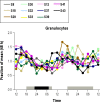Diurnal rhythms in blood cell populations and the effect of acute sleep deprivation in healthy young men
- PMID: 22754039
- PMCID: PMC3369228
- DOI: 10.5665/sleep.1954
Diurnal rhythms in blood cell populations and the effect of acute sleep deprivation in healthy young men
Abstract
Study objectives: The sleep/wake cycle is accompanied by changes in circulating numbers of immune cells. The goal of this study was to provide an in-depth characterization of diurnal rhythms in different blood cell populations and to investigate the effect of acute sleep deprivation on the immune system, as an indicator of the body's acute stress response.
Design: Observational within-subject design.
Setting: Home environment and Clinical Research Centre.
Participants: 15 healthy male participants aged 23.7 ± 5.4 (standard deviation) yr.
Interventions: Total sleep deprivation.
Measurements and results: Diurnal rhythms of several blood cell populations were assessed under a normal sleep/wake cycle followed by 29 hr of extended wakefulness. The effect of condition (sleep versus sleep deprivation) on peak time and amplitude was investigated. Interindividual variation of, and the level of correlation between, the different cell populations was assessed. Comprehensive nonlinear curve fitting showed significant diurnal rhythms for all blood cell types investigated, with CD4 (naïve) cells exhibiting the most robust rhythms independent of condition. For those participants exhibiting significant diurnal rhythms in blood cell populations, only the amplitude of the granulocyte rhythm was significantly reduced by sleep deprivation. Granulocytes were the most diverse population, being most strongly affected by condition, and showed the lowest correlations with any other given cell type while exhibiting the largest interindividual variation in abundance.
Conclusions: Granulocyte levels and diurnal rhythmicity are directly affected by acute sleep deprivation; these changes mirror the body's immediate immune response upon exposure to stress.
Keywords: Human; circadian; flow cytometry; granulocytes.
Figures




Comment in
-
From total sleep deprivation to cardiovascular disease: a key role for the immune system?Sleep. 2012 Jul 1;35(7):895-6. doi: 10.5665/sleep.1938. Sleep. 2012. PMID: 22754031 Free PMC article. No abstract available.
Similar articles
-
Effect of long-term sleep restriction and subsequent recovery sleep on the diurnal rhythms of white blood cell subpopulations.Brain Behav Immun. 2015 Jul;47:93-9. doi: 10.1016/j.bbi.2014.10.004. Epub 2014 Oct 30. Brain Behav Immun. 2015. PMID: 25451611
-
Blood-gene expression reveals reduced circadian rhythmicity in individuals resistant to sleep deprivation.Sleep. 2014 Oct 1;37(10):1589-600. doi: 10.5665/sleep.4064. Sleep. 2014. PMID: 25197809 Free PMC article.
-
Plasma melatonin rhythms in young and older humans during sleep, sleep deprivation, and wake.Sleep. 2007 Nov;30(11):1437-43. doi: 10.1093/sleep/30.11.1437. Sleep. 2007. PMID: 18041478 Free PMC article.
-
Sleep, circadian rhythms, and athletic performance.Sleep Med Rev. 2015 Oct;23:1-9. doi: 10.1016/j.smrv.2014.11.003. Epub 2014 Nov 20. Sleep Med Rev. 2015. PMID: 25645125 Review.
-
Circadian rhythms, sleep, and the menstrual cycle.Sleep Med. 2007 Sep;8(6):613-22. doi: 10.1016/j.sleep.2006.09.011. Epub 2007 Mar 26. Sleep Med. 2007. PMID: 17383933 Review.
Cited by
-
Mistimed sleep and waking activity in humans disrupts glucocorticoid signalling transcripts and SP1, but not plasma cortisol rhythms.Front Physiol. 2022 Aug 17;13:946444. doi: 10.3389/fphys.2022.946444. eCollection 2022. Front Physiol. 2022. PMID: 36060675 Free PMC article.
-
Childhood adversity is associated with heightened inflammation after sleep loss.Sleep Health. 2022 Jun;8(3):283-287. doi: 10.1016/j.sleh.2022.03.006. Epub 2022 May 2. Sleep Health. 2022. PMID: 35513977 Free PMC article. Clinical Trial.
-
The circadian rhythm as therapeutic target in inflammatory bowel disease.J Can Assoc Gastroenterol. 2024 Aug 13;8(Suppl 2):S27-S35. doi: 10.1093/jcag/gwae027. eCollection 2025 Mar. J Can Assoc Gastroenterol. 2024. PMID: 39990511 Free PMC article.
-
Sleep loss and the inflammatory response in mice under chronic environmental circadian disruption.PLoS One. 2013 May 17;8(5):e63752. doi: 10.1371/journal.pone.0063752. Print 2013. PLoS One. 2013. PMID: 23696854 Free PMC article.
-
The influence of biological and lifestyle factors on circulating cell-free DNA in blood plasma.Elife. 2021 Nov 9;10:e69679. doi: 10.7554/eLife.69679. Elife. 2021. PMID: 34752217 Free PMC article. Review.
References
-
- Hastings MH, Reddy AB, Maywood ES. A clockwork web: circadian timing in brain and periphery, in health and disease. Nat Rev Neurosci. 2003;4:649–61. - PubMed
-
- Bollinger T, Bollinger A, Oster H, Solbach W. Sleep, immunity, and circadian clocks: a mechanistic model. Gerontology. 2010;56:574–80. - PubMed
-
- Lange T, Dimitrov S, Born J. Effects of sleep and circadian rhythm on the human immune system. Ann N Y Acad Sci. 2010;1193:48–59. - PubMed
-
- Laposky AD, Bass J, Kohsaka A, Turek FW. Sleep and circadian rhythms: key components in the regulation of energy metabolism. FEBS Lett. 2008;582:142–51. - PubMed
Publication types
MeSH terms
LinkOut - more resources
Full Text Sources
Research Materials

